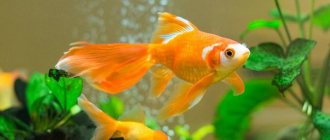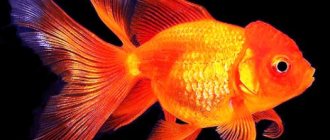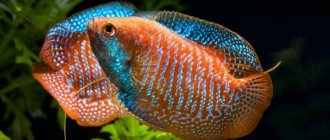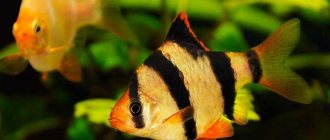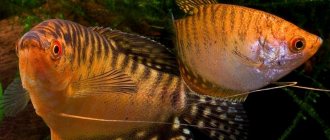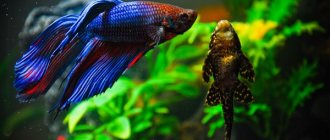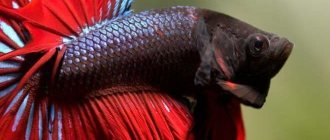Bettas are beautiful aquarium fish that have earned a bad reputation due to their personalities. Alas, these fish are pugnacious and do not tolerate either intraspecific proximity or with many other species. However, there are certain breeds that are loyal to such temperamental neighbors. Before combining several individuals of different species in one space, you must definitely find out the compatibility of the cockerels. Otherwise, conflicts can even lead to the death of its participants.
Cockfighting is a deadly competition.
Is it possible to keep a betta with other fish?
The fish belongs to the labyrinth family. Males of the species are seriously large, up to 7 cm.
Cockerels have become so popular among aquarists due to their unusually attractive appearance. The fish can be bright orange or red colors. Blue and green specimens are often found. The fact that the color of the cockerels shimmers and new shades appear all the time is also eye-catching. An amazing natural feature: during a fight, the color of the cockerel becomes even brighter. In addition, they show their most wonderful color during mating period - this is how they attract the attention of their partner.
Cockerels are very diverse and this attracts increased public attention.
Female bettas are less colorful, their fins are slightly shorter, and their bodies are fuller. Today, breeders are seriously engaged in raising females of the same beauty as males. Alas, these individuals are not yet available for sale.
Either sex of fish has similar characteristics. So, the fish have stripes along their entire body. The fins are round in shape. The fin below has a maximum length. It extends straight from the fish's head and ends at the base of its tail. The pectoral fins have a sharp shape. If the fish’s condition is atypical, for example, it is preparing for battle, then the gills swell, forming a beautiful collar around the neck.
Cockerels can breathe ordinary air - the so-called labyrinth organ provides this opportunity. Therefore, it is very important to ensure that the outer water layer is clean so that air can pass freely. But you should also take care to ensure protection against jumping out using a special mesh. These fish are excellent jumpers, so they can jump out of an open container.
Distillate is not used, since bettas only accept soft water. Aquarium owners buy special products in stores that will purify the water and make it more nutritious.
Feeding cockerels is possible not only with dry food, but also with live food. They are very fond of earthworms and bloodworms. They are given food once or twice a day, under no circumstances allowing them to overeat.
Considering all these features of aquarium fish, it becomes clear that keeping them with neighbors is very problematic. Cockerels do not get along well even with each other, let alone other species.
But all problems are solvable. There are some types of aquarium fish that are loyal to bettas, and such proximity will not cause them discomfort. But you must take into account these important points:
- Fish with long fins should not be allowed into the aquarium where the betta is located. He will immediately see him as an opponent, which will lead to a serious collision. Their meeting can lead to serious injury and death.
- The betta should not be kept with other fish that have the same character. Even if males do not appear to show aggression, this does not mean that there will be no fight. They can fight at any time, for example, when the owner of the aquarium is fast asleep. Alas, such quarrels often end in the death of one of the fish.
- He shouldn't be in cold water. In this case, its color will instantly fade, and an unsightly cloudy sheen may appear. All this leads to diseases, so you can’t keep them with goldfish because of the temperature difference.
- Even if the neighbors have gotten along well with each other and there are no problems, the aquarium owner should carefully monitor them for at least a few weeks. It is possible that there will be a conflict, but later, since for now the fish simply have not appreciated each other’s capabilities.
- Small fish or those who have not yet reached adulthood cannot be placed in the same aquarium with bettas. It is especially not recommended to house individuals whose body length is less than 4 centimeters. The cockerel will think that this is just food for him, and will certainly begin to behave aggressively.
- The calculation should be made in such a way that for each rooster there is at least five liters of water. If neighbors are included, the volume increases significantly. Experts believe that to keep 5 or more bettas, you need an aquarium of at least fifty liters.
We recommend starting the relationship between a betta and any other fish at a young age.
- There is a way out if the cockerel is still small. It can be added to other fish until puberty. It is likely that he will get used to it and will not behave aggressively. However, this method does not guarantee that everything will be successful.
- The explosive nature of this bright fish is not liked by predators and large individuals. Fish that weigh more than a betta will not appreciate their new neighbor. A betta's reactions can result in serious injury and even death.
It is clear that the cockerel does not live next to everyone. And even if all the conditions are met, this does not guarantee one hundred percent success. Much depends on the very nature of the fish, the characteristics of those individuals with which it will coexist.
Betta fish: care and maintenance
Cockerels are unusual, incredibly bright and exotic fish. Aquarists love them very much not only for their beautiful appearance, but also for their fighting character. However, in order for these fish to please their owners for a long time, they need special care. This article contains information regarding the features of keeping and breeding cockerels in an aquarium.
Origin
Southeast Asia is considered the birthplace of the betta fish. Its main habitats are warm, fresh, slow-flowing or stagnant bodies of water in Thailand, Vietnam, the Malay Peninsula and the islands of Indonesia.
The first mention of this unusual fish occurs in history in 1800. At that time, the inhabitants of Siam (now Thailand) noticed the increased aggressiveness of the males of this fish towards each other and began breeding a special breed for fights with monetary stakes.
Cockerels were introduced to Europe in 1892. The first countries to see the miracle fish were France and Germany. They came to the USA in 1910, where Frank Locke developed a new color version of the cockerels. In Russia, the history of their appearance is associated with the names of V.M. Desnitsky and V.S. Melnikov and date back to 1896.
Compatibility
Reproduction
Diseases
Interesting Facts
- In South Asia, cockerels were used for fighting with money stakes. Fights, as a rule, did not lead to the death of fish; it ended with frayed tails. Now such fights are prohibited.
- A male cockerel can fight until he is completely exhausted even with his reflection in the mirror.
- These fish are endowed with two respiratory systems: gills and a labyrinth organ.
- Cockerels show sympathy for the opposite sex in a very interesting way: the female “fidgets” back and forth, and the male protrudes his gills and fins and wriggles his whole body.
Useful tips
You should not pet your bettas too often (although they allow it), as some owners do. The scales have a protective layer of mucus on top. If this film is accidentally damaged, the fish will become very vulnerable to various diseases.
Sometimes bettas can lie down on the bottom of the aquarium. If this does not last long, then there is no need to worry - this is how they rest. The alarm should be raised if this behavior has been observed for a long time. Then you need to contact a specialist and check the health of the fish.
If the fish are sick, there are special medications to treat them (antifungi or parasites, antibiotics). It is better to order them at the pet store in advance.
We hope that this article was useful for those who are planning to place a betta fish in their aquarium. Let your pet feel comfortable and enjoy its beauty for a long time!
And according to tradition, a video that talks about the rules of care and maintenance of a Siamese cockerel:
Description and varieties
Betta fish (betta, Siamese betta, Betta splendens) is a species of fish that belongs to the macropod family. This is a labyrinth fish that also uses atmospheric air for breathing.
The body shape of cockerels is oval, it is flattened laterally and elongated in length. The sizes of the fish are mostly small: males are about 5 cm, and females are 4 cm. However, there are individuals that can reach 10 cm in length. The caudal and upper fins are rounded, the pectoral fins are pointed. The fins of males are longer than those of females.
Cockerels have very interesting and varied colors. They come in one, two or multi-colors. The color can contain all the colors of the rainbow, as well as their shades. Males are brighter colored than females.
The lifespan of a betta fish is approximately three years.
To date, breeders have bred about 70 species of cockerels. All of them have a bright unusual color. There are several classifications of species.
Depending on the fin shape and size:
- veiled;
- crescent-tailed;
- crown-tailed;
- two-tailed;
- round-tailed;
- delta-tailed;
- brush-tailed;
- flag-tailed;
- poster;
- royal.
Depending on the color:
- plain;
- two-color;
- multicolor.
How to equip an aquarium?
Betta fish are considered unpretentious and easy to care for, but some conditions must be met.
Bettas can be kept in both small (10-15 l) and large aquariums. One individual requires 3-4 liters of water. If the aquarium is large, then it can be divided into several parts by partitions. In this case, several males can be kept in one container at the same time without compromising their health.
The partitions are made of transparent non-toxic material with small holes for water circulation. It is better to plant tall plants next to them to block the fish’s view and reduce unwanted encounters.
Water
Air
The cockerel is a labyrinth fish, that is, it breathes not only with gills, but also with an additional special organ. In it, the blood is saturated with air, which the fish captures with its mouth. Therefore, aeration is not very important for cockerels, but it is advisable to install a filter. It can be of low power, since these fish do not like strong currents.
It is also important that the surface of the water is not completely overgrown with plants, so that the betta can rise to the surface and take in air. Sometimes it happens that a bacterial film forms on the surface of the water. It needs to be removed. This can be done using a sheet of paper, placing it on the surface of the water, and then removing it along with the film.
Priming
Plants
Decorations and lighting
Nutrition
Cockerels are not picky eaters and are practically omnivorous. You can use live, dry and frozen food for them. Nevertheless, the majority of the diet should be live food (bloodworms, tubifex, daphnia, cyclops, etc.). Cockerels will not refuse earthworms or flatworms, snails or zooplankton.
Feed the fish 1-2 times a day. Just enough food is given at one time so that the fish eat it completely in 15 minutes. Remains must be removed immediately. Overfeeding is not recommended, as this can lead to obesity in the fish. It’s good to have a fasting day once a week.
What factors affect compatibility?
It is advisable to have a male and female betta in the same aquarium. Moreover, for one cockerel there should be two or more females. If you want to add other fish to the aquarium, then you should avoid brightly colored specimens of other species. Fish with veil fins are also not suitable. Often, cockerels mistake such fish for competitors and boldly enter into battle with them.
Predatory fish will not make good neighbors for bully bettas. In addition, the latter should not be housed with large individuals, since unequal weight categories can have disastrous consequences for striking beauties.
Representatives of the Labyrinth suborder do not get along very well in one aquarium - this is worth taking into account. Of course, you can create special conditions, but it’s still better not to take risks. In general, even in controversial combinations of bettas with other fish, much depends on certain circumstances and the nature of the species being compared. Often a spacious aquarium can smooth out many conflicts between its inhabitants.
When introducing bettas to other fish, it is important to closely monitor them for the first few days. Having noticed a tense situation under water, you should resettle the warring fish.
Whether fish breeds are compatible or not within the same aquarium should be determined based on the needs for the same water characteristics. If the temperature is not suitable for one of the species, this can cause an attack of aggression and even death.
There is no place near the cockerels for small fish less than 4 centimeters long. In this case, the fighters will certainly have a desire to show their superiority. As a result, the weaker fish will lose.
It is convenient to keep bettas with other fish in a long aquarium, since they can easily be separated from each other by glass partitions. You can even keep several males in such compartments. In addition, with such maintenance, the cockerels become brighter and more beautiful. This is due to the fact that they see rivals and try to intimidate them with rich colors and warlike poses.
Character of cockerels
The homeland of these creatures is Asia, namely Thailand and Siam. They are found in small bodies of water. There they live well in stagnant water at a temperature of 21-27 degrees.
Two male bettas in an aquarium with a partition.
Some aquarists use a little trick. The fact is that at the sight of an opponent, the cockerels become brighter and take on a warlike appearance. Of course, it is much more interesting to watch them in this state, and therefore the holders of these fish buy long aquariums and divide them into compartments in order to seat the bettas, however, to give them the opportunity to see each other.
It is not for nothing that the cockerel is known for its increased pugnacity. This is a fighting Siamese fish with an irreconcilable character. Bettas fight both with each other and with representatives of other fish species . It is no coincidence that these fish even got their cute name, because with their color and corresponding behavior they resemble roosters - birds whose quarrelsome nature needs no introduction. No matter how beautiful the fish the bettas are, their pugnacity always causes many problems.
The fighting even within their species is very brutal. Loose fins and tail, sudden movements: you should separate the cockerel as soon as you see that they rushed into battle, otherwise one of them will most likely die.
Surprisingly, in Asia they even hold specially organized fights between these wonderful creatures. Their bright colors are not valued, but their fighting spirit is valued. The fights attract crowds of onlookers and people even place bets on the cockerels. A fish cannot die in such a fight; most often, rivals get away with torn fins.
A flock of female bettas in one aquarium.
Females also know how and love to fight, however, they are more tolerant of each other’s company. Females can be kept in one aquarium in flocks of 3-5 pieces.
If a betta is too aggressive, it cannot be kept with other fish in principle, and then its owner has only one choice - a single aquarium for his pet. A cockerel is very rare in a community aquarium.
Who can they get along with?
In fact, many fish can live in the same aquarium with bettas. To understand which ones, you can consult with experienced aquarists. In addition, a special table of compatibility with cockerels will help you deal with this issue.
- Mollies will be a good neighbor for a betta. This dim neighbor is very peaceful, which makes her invisible to the cockerels. However, you will have to put her fry in a separate container so that they do not get eaten.
- Angelfish can also be kept with bettas, as they are not interested in them. The only condition is a spacious aquarium. It is worth considering that the container must have shelters. Indeed, during the spawning period, angelfish can be aggressive and can themselves attack their neighbors.
- You can also add gourami to the cockerels. These fish have quite similar personalities. The neighborhood will be peaceful if they are kept in a container with a volume of 80 liters or more. Even if these little fish are chasing each other, don’t be scared - these are just games in which no one will harm anyone.
- The cockerel is also friends with corydoras. It is worth noting that these close relatives of catfish get along well with many species. Friendly cleaners are simply invisible to active, colorful bully fish. A huge advantage is that this species also breathes atmospheric air, which simplifies its maintenance.
- Ancitruses have a dull color and are distinguished by a calm character. They are excellent neighbors for many fish species, including bettas.
- Neons are also suitable as neighbors, but different temperature conditions may prevent them from becoming neighbors.
- The small size and dull coloring make it possible to add cardinals to the cockerels.
- Small and fussy, danios can get along well with bettas. The latter simply do not see them as competitors.
A good peaceful neighborhood can result if the cockerel is accompanied by a lalius or a macopod. In addition, colorful fighters will be able to live peacefully in an aquarium with brocade catfish, cockroaches, acanthophthalmus, pulchrypinnis, speckled catfish, gastromyzons and some other species.
In any case, before choosing suitable inhabitants of your aquarium for bettas, it is advisable to ask for help from a sales consultant.
With whom is cohabitation possible, but not very desirable?
There are fish with which bettas can, of course, cohabit, but it is better to avoid this or create special conditions for each species. For example, a botia is suitable as a neighbor for fighters if it lives in a group of up to 8 individuals. It is also mandatory for them to have decorative elements in the aquarium. Otherwise, they are not guaranteed a normal life.
Rasboras can live with bettas due to their agility. It is this quality that allows them to simply run away from offenders during conflicts. However, you will need to install various shelters so that they have somewhere to hide in case of danger.
Tetra, if it is solitary, is aggressive, therefore, in order to avoid conflicts with cockerels, it is advisable to house representatives of this species in flocks. Cohabitation is also facilitated by the presence of algae and various decorative elements.
It won't be the best to be around guppies. Firstly, these fish need different characteristics of aquarium water, and secondly, during the race, guppies may be left without their luxurious fins.
It is not advisable to house fighters with barbs, swordtails, goldfish, and some catfish. It is better to keep these types of fish separately from the bettas. If there is a strong desire to make them neighbors, a good option for doing this would be to release fry of the desired species of the same age as the fry of the cockerels. They will get used to each other from a very young age and will not compete.
Pecilia and ternetsia can coexist, but only if special conditions are created.
Tips for keeping a community aquarium
So, it is easy to understand whether the bettas will get along with other fish in the aquarium. It depends not only on their temperament. The following factors need to be taken into account:
- Volume and dimensions of the aquarium;
- Availability of shelters, decorations, algae;
- Age and number of fish;
- Characters of species and the temperament of a particular individual.
The cockerel gets along with other fish like this:
- Corydoras catfish;
- Danio;
- Mollies;
- Speckled catfish;
- Rasbory;
- Tetras;
- Plants and snails.
Compatibility chart for bettas with other fish species.
You can keep it together, but certain requirements must be met:
- Angelfish;
- Cockerels;
- Gourami;
- Boots;
- Labeo.
But cockerels will absolutely not be compatible with fish such as:
- Barbs;
- Cichlids;
- Discus;
- Goldfish;
- Koi Carps;
- Astronotuses.
Keeping them in a common aquarium is problematic. A conflict may not arise immediately; it will seem that everything is in order and the fish are normally disposed towards each other. However, such indifference is just an appearance before the attack. A fight will certainly happen, and can end disastrously for each of the individuals.
06:15
MYSTERIOUS AND BRUTAL BATTLE OF COCKER FISHES – THE FIN BIT OUT
You need to understand that it is only possible to introduce an adult of a different species. Only a fish that is approximately the same size as hers can live with bettas. Bettas will corner small ones and attack, thinking they are prey. Sometimes small fish coexist peacefully with a cockerel, but this only applies to those individuals that swim in schools. You should also pay attention to the following points:
- You should not allow cockerels into an aquarium where brightly colored fish are kept - they will certainly fight, most likely it will be the betta that incites the conflict;
- The species will also not tolerate proximity to predatory individuals - this can end in failure;
- It is imperative to set the average water temperature, it is important that the temperature is uniform everywhere;
- Decorations and plants are installed not only for decoration, but also so that the betta’s neighbors can hide during her attacks of aggression.
Cockerels are really quarrelsome, but if your desire to add one to the aquarium is great, you can always find such an opportunity.
Despite the fact that cockerels are quite conflicting, quarrelsome and difficult to get along with, they require special conditions for keeping, they remain favorites of aquarists. The point here is rather in their special fishy “charisma” and excellent external data. Often owners of bettas give them names; what other fish could this happen to?
Who is it contraindicated to be in proximity to?
Under no circumstances should you add snails to your cockerels. The fighting nature of fish tells them that small individuals are excellent for feeding. Although cockerels can also cause harm to larger specimens of mollusks, for example, by biting off their antennae.
Shrimp are also not suitable for proximity to handsome creatures. After all, predatory cockerels will probably want to feast on them. From here it is worth concluding that you should not place any very small fish and other harmless inhabitants of aquariums with them.
A peaceful life will not be possible for cockerels with black-striped cichlas, discus, brightly colored parrots, eels, and astronotuses.
What you should pay attention to
Aquarium volume
Single bettas can live without problems in aquariums of about 10 liters. However, if you decide not to limit yourself to just one fish, then take care in advance of a container of a suitable size, and the larger the volume, the more comfortable the coexistence of the fish will be.
Shelters
When keeping such temperamental fish as bettas, you always need to be prepared for possible conflicts. To minimize the consequences of skirmishes, equip the aquarium with sufficient hiding places. First of all, plant more living plants, put up driftwood and artificial grottoes. Shelters will allow the fish to hide from the aggressor in time.
Behavior Observation
Keeping bettas in a community aquarium requires constant vigilance. Be sure to control the attitude of the cockerel towards its neighbors. If he chases other fish or makes attempts to gnaw off the fins of his neighbors, then the best option would be to put the “evil one” in a separate aquarium.
Possibility of single content
If you still had to remove the betta from the community aquarium, then don’t worry. These fish are solitary by nature, and the lack of company will not bother them at all.
DISEASES OF MACROPODS: CAUSES AND TREATMENT
HOW TO DISTINGUISH A FEMALE FROM A MALE MACROPOD?
ZANIO HOW TO DISTINGUISH A FEMALE FROM A MALE
HOW TO DISTINGUISH A FEMALE FROM A MALE MOLLINESIA?
Is it possible to keep two bettas in one aquarium?
The betta fish is very aggressive, so it is not recommended to combine them in groups in a common tank. This is especially true for males. The character of cockerels is cocky. In the process of fighting for territory, the fish cause severe injuries to each other. The fight will not end in death, but the fins of both individuals will be torn.
Females are less aggressive. They can live in one aquarium of 4-5 pieces. There are situations when females begin to fight. In this case, you should not neglect the conflict and move the aggressive fish into a separate aquarium.
You can place one male and several females in one aquarium. Such cohabitation will not lead to conflicts and fights.
Two cockerels separated in an aquarium

